Crafting the Perfect IT Strategy: A Guide to Business Objective Alignment
Nearly every single business uses a computer or some form of technology in their day-to-day operations. With the accelerating pace of technological advances, crafting the perfect Information Technology (IT) strategy has become critical for businesses across all industries. It’s no longer optional but a cornerstone for success in today’s digital landscape. Aligning your company’s IT initiatives with its broader objectives (read: the business objectives) is critical for achieving desired outcomes, driving growth, increasing efficiency, and gaining a competitive advantage in your industry.
This guide offers a detailed and comprehensive exploration of the fascinating terrain of developing IT strategies. You’ll better understand why this aspect of IT cohesion with the business is crucial in modern times and how it connects to the broader business goals. The guide will walk you through various elements, providing a comprehensive understanding of the IT strategy development process.

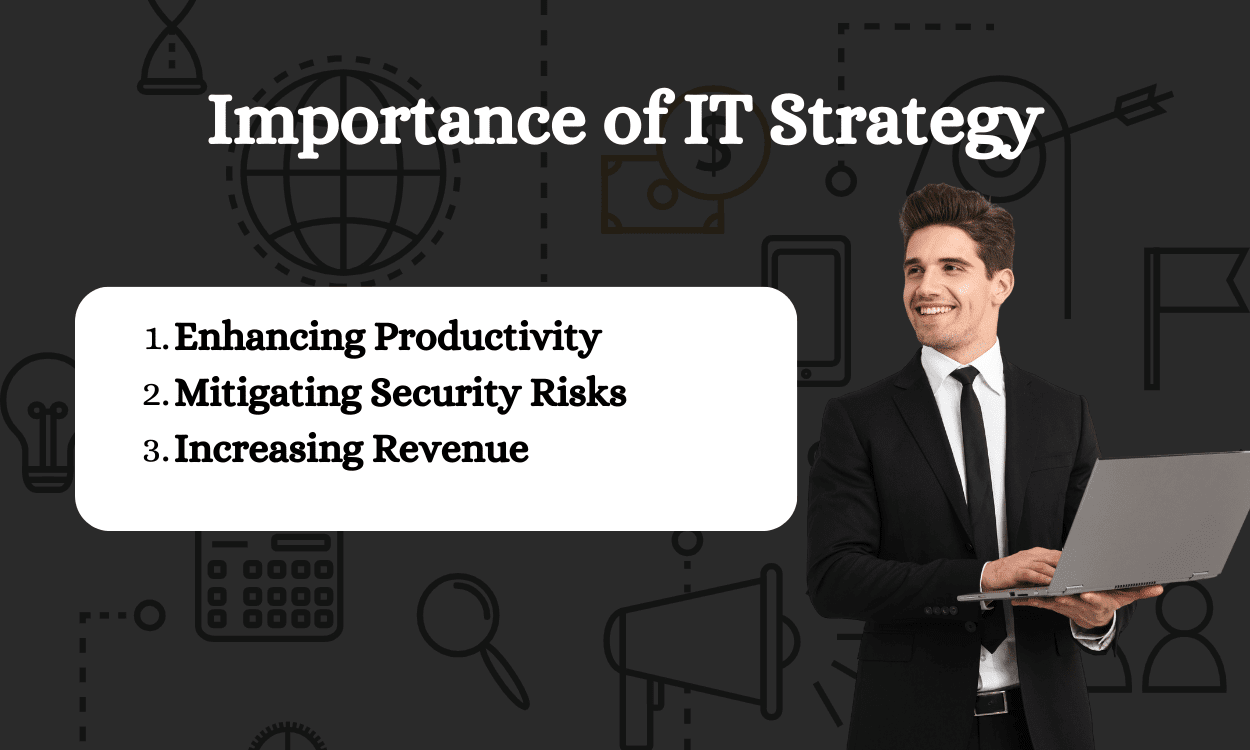
The Importance of IT Strategy in Modern Business
In our technologically driven age, any business aiming for significant growth and competitive advantage must prioritize the development of an effective information technology strategy. Having a comprehensive and robust ‘business IT strategy’ is invaluable for:
- Enhancing productivity, innovation, and creativity
- Mitigating risks and ensuring security
- Demonstrating better revenue growth, as evidenced by Gartner’s study
This underscores just how pivotal having a strategically planned approach toward handling technology is to your company’s bottom line. The inherent adaptability of a well-crafted IT strategy is critical to realizing these benefits. Gracefully accommodating new technologies and market changes ensures sustaining viability amid turbulent times—like 2020 when shifts in IT strategies became critical due to the pandemic’s drastic effects.
The relationship between business strategy and information technology is joined at the hip and mutually beneficial. It constantly interacts to promote a culture of proactive adaptation rather than reactive change. Therefore, keeping a pulse on emerging trends allows businesses to quickly adjust their course, ensuring that they remain at the forefront of their industry sectors.
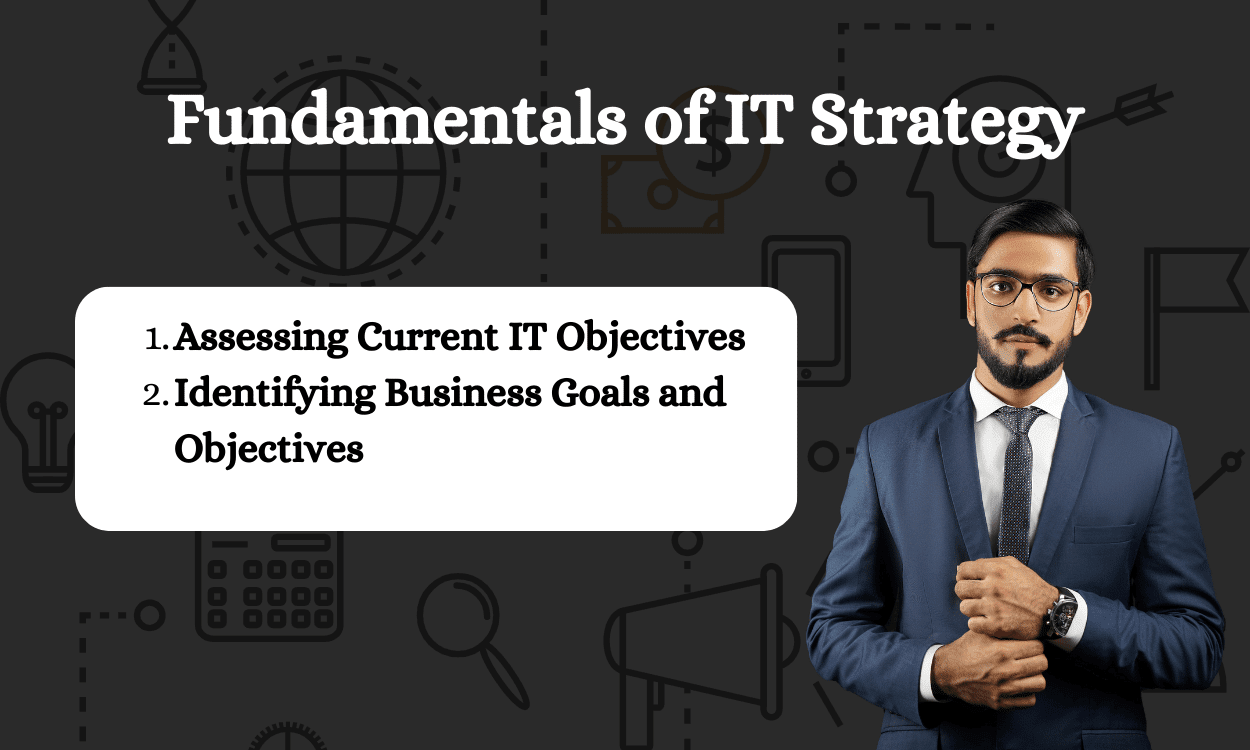
Fundamental Principals of IT Strategy Development
Crafting a robust IT strategy requires a thorough understanding of critical principles in IT strategic management. The goal is to bridge the gap between your technological resources and overarching business objectives.
Assessing Current IT Objectives
The first fundamental step in an IT strategy planning process is assessing and understanding existing technology-related goals.
Keep these questions in mind: What is the present role of technology within your organization? How efficiently are current systems and software applications meeting needs? Are there underutilized or even unused resources draining the budget without producing value?
Your strategy should examine your current technology stack for viability for a six-to-twelve month lens which will provide insight into future positions in three to five years. Hence, it becomes necessary to audit current practices. This activity illuminates opportunities for improvement and unearths challenges that need addressing.
Some areas to consider during the assessment might include the following:
- Existing hardware used for daily operations
- Software applications (on-premise and SaaS) utilized across departments
- Data management procedures currently implemented
- The effectiveness of tech-backed communication channels
You can gather ample data points regarding system performance by scrutinizing all these IT facets, especially the budget and past 12 months spend. You can spot difficulties that forestall effective strategic planning for information technology, identify redundancies, and streamline your assets.
Identifying Business Goals and Objectives
After analyzing your situation through the lens of IT, you’re ready to identify organizational objectives—what do you intend to achieve as a business entity?
Start by clearly articulating broad vision statements and specific, measurable goals supporting this vision. Your company may want to minimize costs, refresh technology with AI, boost revenue, expand its customer base, or innovate new products/services. Once identified, start sizing up how IT could aid those endeavors.
This task requires the active collaboration of various stakeholders within an organization. Executives leading different divisions must collaborate to share their unique perspectives and insights. It is important to involve the finance department for budgeting concerns, human resources for workforce capability planning and management, and marketing and sales teams for customer acquisition strategies.
By collaboratively identifying business goals and objectives, you ensure that your forthcoming IT strategy is informed and well-rounded. This strategy paves the path towards future-proof processes underpinned by technology that deliver meaningful impacts on business performers.
To implement strategic IT management successfully, evaluating your current IT state and understanding where you want to take your business unit is important. Ultimately, the goal is to connect these two endpoints – where you stand now and where you want to be.
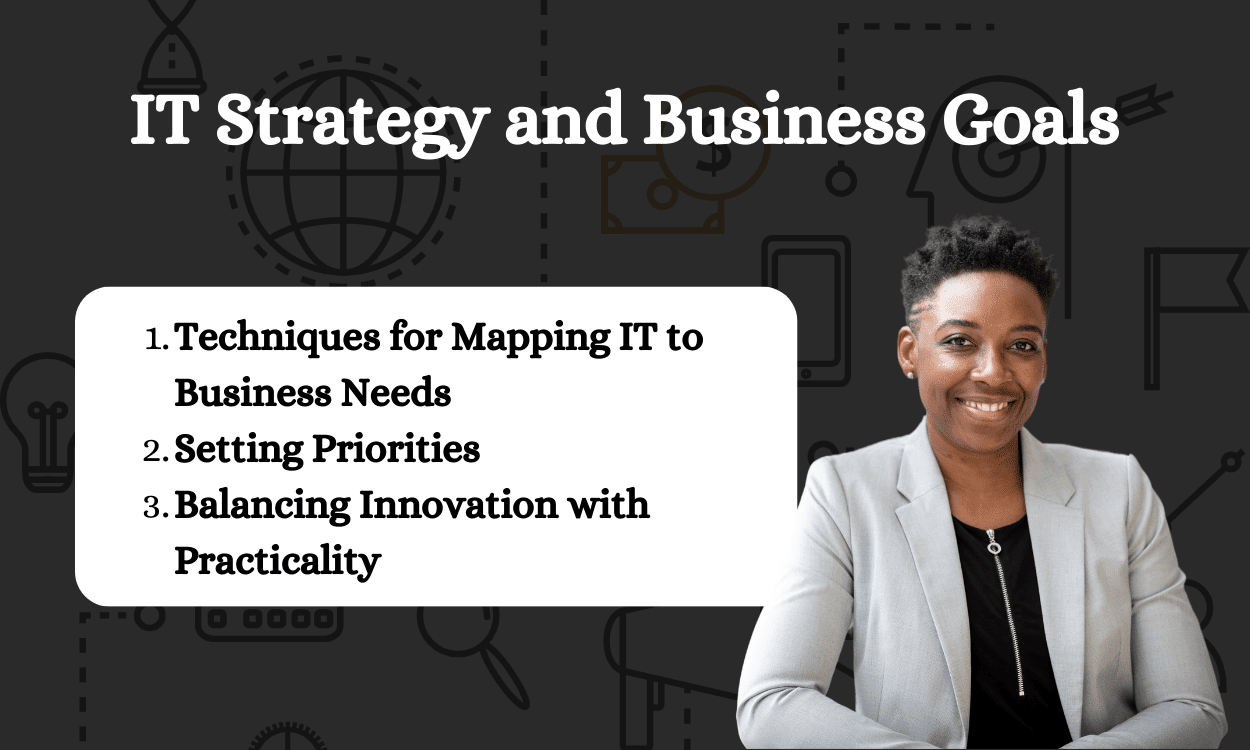
Aligning IT Strategy with Business Goals
It is crucial to align a company’s business strategies with information technology (IT). These two processes are like two sides of the same coin. When aligned correctly, they provide sufficient support for achieving business objectives while making the most of technological resources.
Techniques for Mapping IT Capabilities to Business Needs
One critical step in creating an effective business IT strategy is to map out your current IT capabilities relative to your business needs. This helps identify areas where technology can address any shortfalls and improve operations.
Here are a few techniques you can use:
- Gap Analysis: Identify discrepancies between existing IT infrastructure and required capabilities. Examine key performance indicators like system uptime, efficiency, and user satisfaction.
- Portfolio Evaluation: Evaluate the company’s software or hardware portfolio to check which tools are underused or outdated.
- User feedback: Regularly consult various departmental teams across your organization to evaluate how well current systems meet their needs.
- Maturity Assessment: Involves a systematic evaluation of your organization’s IT processes, tools, and strategies against established maturity models or frameworks. These models, such as the Capability Maturity Model Integration (CMMI), IT Infrastructure Library (ITIL), or the COBIT framework, define various levels of maturity for processes ranging from initial/ad hoc practices to optimized and continuously improving processes.
These methods provide valuable data to guide the restructuring or enhancement of your IT framework according to specific business realities.
Setting Priorities and Defining IT Roadmap
Next comes setting priorities based on what you learned from mapping out your capabilities versus needs alongside understanding your strategic objectives.
This involves creating a prioritized list of tech initiatives based on their impact on business execution, followed by drafting a roadmap with projected milestones to align these improvements with organizational strategies.
Milestones should include:
- Engaging stakeholders for approval
- Allocating needed resources
- Planning the specific implementation steps, including testing procedures
- Ensuring proper support and maintenance plans post-implementation
Flexibility is vital when defining an IT roadmap due to constantly evolving market conditions and emerging technologies.
Balancing Innovation with Practicality
While it is important to have a forward-thinking approach in designing an effective IT strategy for your business, it is equally important to exercise caution and avoid getting overly caught up in the allure of innovative yet potentially premature or inappropriate technologies.
It is crucial to balance adopting new technologies with carefully allocating resources. This means:
- Ensuring that any new solutions adopted enhance rather than complicate existing workflows,
- Making sure these solutions are robust enough to withstand future technological shocks while being flexible enough for potential alterations.
Success lies in ensuring that IT tools and systems align with your business objectives without overstretching your resources.
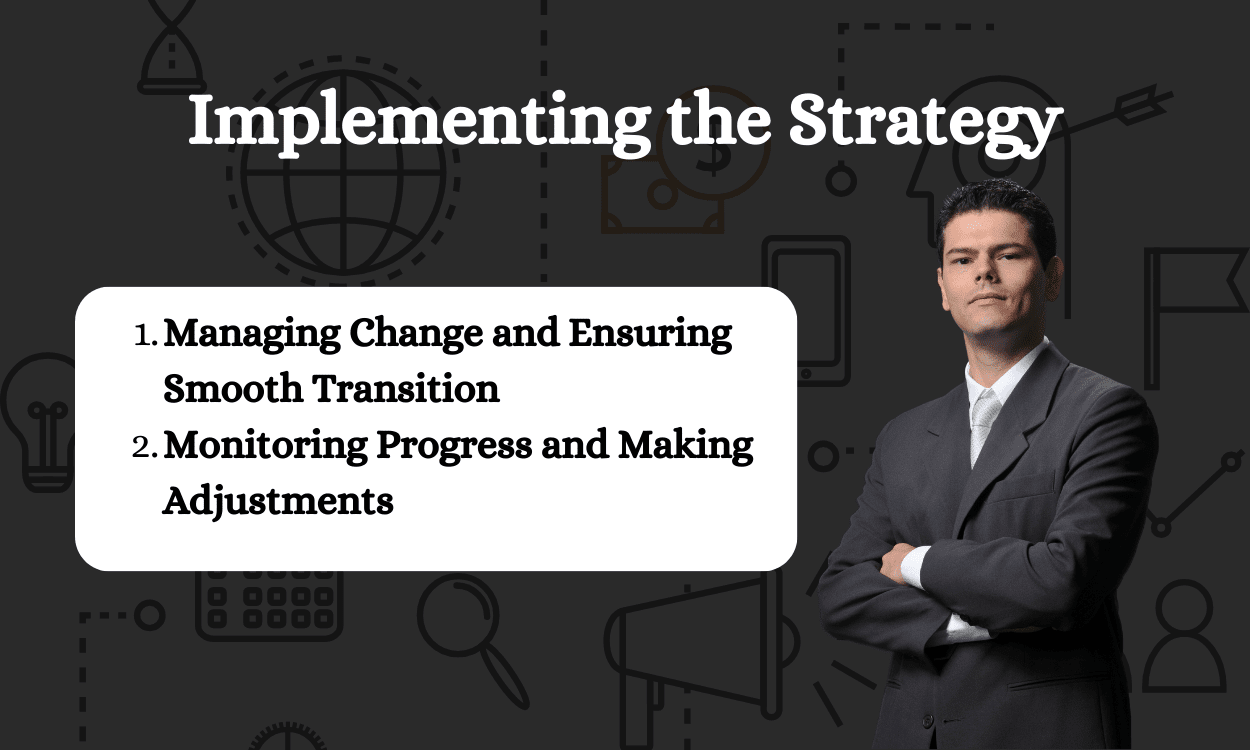
Implementing the Strategy
After developing your IT strategy, the next step is to implement it. During the implementation stage, businesses may face some challenges. There are two crucial steps to implementing a new IT strategy. The first step involves managing the changes that come with the transition to ensure a smooth process. The second step is to monitor the progress and make necessary adjustments as required.
Managing Change and Ensuring Smooth Transition
As with any significant initiative within a company, you will encounter some resistance. People fear what they do not understand or what disrupts their routine. However, navigating unforeseen shifts becomes more manageable if you tackle change management correctly.
- Communicate clearly and constantly: Explain why the change is necessary for the business and how everyone benefits from it. The objective is to ensure team members are on board because they comprehend its implications on both personal and organizational levels. Provide avenues for constant feedback and two-way communication. Transparency is key!
- Provide resources and training: It is only fair that people familiarize themselves with new tools, technologies, and platforms before executing tasks precipitously. Therefore, adequate resources (guides, manuals) and training sessions should be provided to ease employees’ worries about unfamiliar procedures.
- Take a phased approach: It’s usually more beneficial to roll out changes in phases rather than all at once- This allows everyone ample time to adjust accordingly. Furthermore, quick wins help justify the investment and keeps the momentum rolling throughout the organization.
Monitoring Progress and Making Adjustments
After implementing the strategy, meticulous progress monitoring and fine-tuning must be completed.
- Establish critical metrics: Identify vital aspects that contribute to gauging the overall success of IT strategy. These benchmarks are indispensable since they offer tangible insights into whether things are moving in the right direction.
- Continuous evaluation: Regular check-ins enable us to determine if we’re hitting our targets by the chalked-out timeline. If not, a step back to analyze hindrances becomes mandatory. You may need to adjust your strategy or amend aspects of execution.
- Be flexible: This is key when it comes to IT strategic management. Stay open-minded and adaptable, promptly adjusting course according to the company’s needs without forgetting that the ultimate goal remains steadfast: aligning business objectives.
While devising an IT strategy poses challenges, executing it requires just as much caution—if not more so—to yield the desired results. Successfully navigating change introduction and constant monitoring will allow your organization to thrive under an effective IT strategy—guaranteeing fruitful long-term outcomes for your enterprise.

Overcoming Common Challenges
Crafting a robust IT strategy is no small feat. It’s often laced with challenges that can hold back even the most seasoned strategic planners. Two significant obstacles often appear- resource constraints and staying agile in a fast-paced tech landscape. Let’s explore these hurdles more closely, focusing on effective strategies for overcoming them.
Addressing Resource Constraints
Firstly, let’s discuss ‘resource constraints’. At some point, every organization encounters the challenge of having ambitious goals but insufficient resources to achieve them. In the context of IT strategic management, this could manifest as a shortage of technical expertise, inadequate IT infrastructure, or financial limitations that impede investment in new technologies.
Here’s how you can address each:
- Lack of technical talent: Identify whether this is a short term problem which you can solve with consulting dollars or implementation partners or a long-term problem with lack of technical competency. For the former, identify a key partner or work with a group which can provide burstable, knowledgable resources. For the latter, building solid partnerships with academic institutions and research centers can create pipelines for fresh talents. Mobility programs or recruitment fairs are also effective routes to attract budding tech wizards. When in doubt, any number of recruiting firms can help fill your talent void.
- Inadequate IT Infrastructure: Consider leveraging scalable cloud services that offer elasticity as your business needs fluctuate. Regular auditing and decommissioning of outdated systems help keep the existing infrastructure trim and efficient.
- Financial Constraints: Analyze where cost-saving measures can be incorporated without hampering functionality—partnering with vendors offering cost-efficient solutions should be explored extensively.
Staying Agile in a Rapidly Evolving Tech Landscape
Another challenging aspect of IT strategic planning is to stay agile amidst an ever-evolving technological landscape—a true test for any contemporary organization.
To tackle this constant change head-on:
- Immerse yourself in continuous learning: Keeping up with the newest technological advancements should become second nature within your organization’s culture. YouTube, networking groups, and white papers are a good start to learning.
- Foster an agile mindset: Decentralize decision-making processes to allow bottom-up innovation–and encourage staff from all levels to contribute ideas.
- Encourage experimentation: Risks are inherent in technology adoption; learn to embrace failure by encouraging “safe to fail” experiments.
In quantifying agility, develop a set of key performance indicators (KPI) that reflect your company’s agility level, such as the time to deploy new systems or respond to technical difficulties. These measures can form part of ongoing strategy evaluations, ensuring you hit targets in these crucial areas.
Navigating resource constraints and maintaining agility amidst technological evolution takes work. However, with careful strategic thinking and resolute actions, these challenges can be converted into opportunities for IT strategy refinement, leading to a more effective alignment between business objectives and IT capabilities.
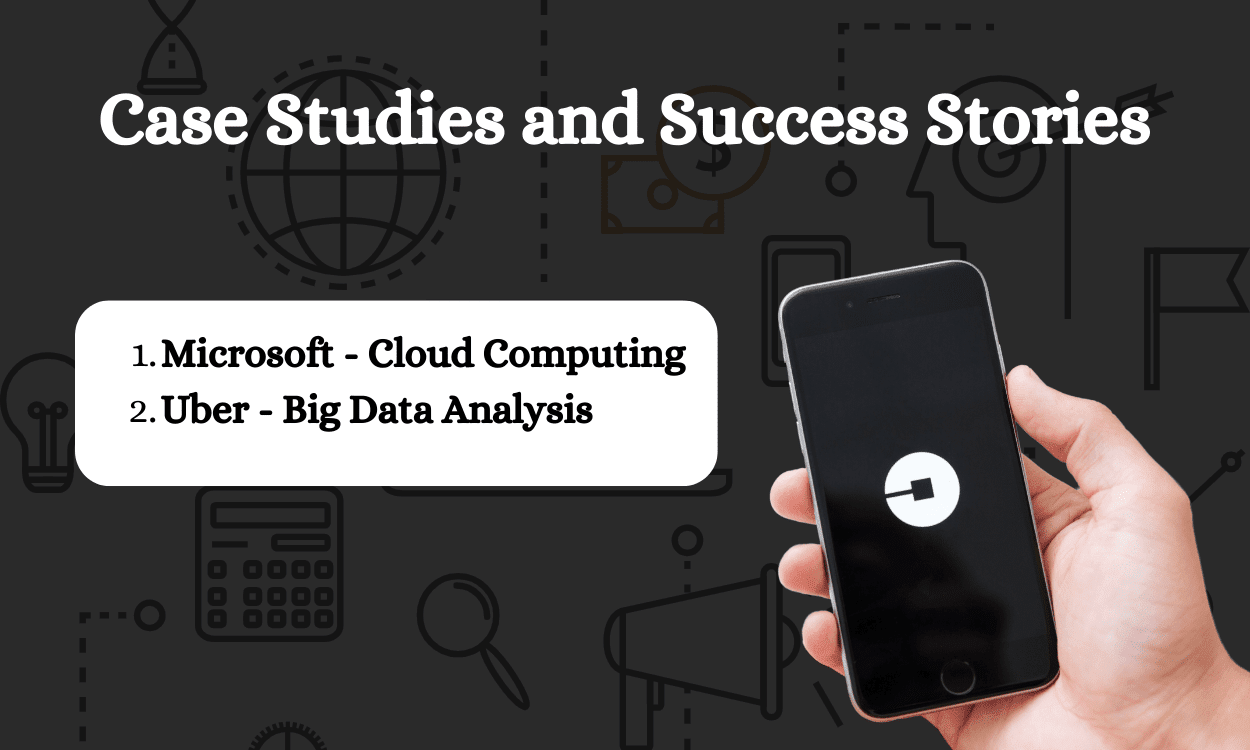
Case Studies and Success Stories
You’ve read through the principles, techniques, and challenges of crafting an IT strategy that aligns with business goals. However, you might ask yourself one crucial question: Does this work in practice? This section dives into notable examples of successful alignment between business objectives and respective IT strategies to provide answers to this query.
Tech Titan Microsoft Aligns Business Objectives with Cloud-Computing Strategy
In a world increasingly moving towards cloud-based solutions, tech giant Microsoft underwent a strategic repositioning under CEO Satya Nadella. The new vision emphasized transforming the company into a cloud-first enterprise. This was an IT strategy and a clear direction for their broader business agenda: to enable digital transformation for their clients across different industries.
Azure, their flagship cloud product, became central to their operational and market approach, perfectly synchronizing with their long-term objective of sustainable growth in the rapidly expanding cloud computing marketplace.
Transport Service Uber Makes Use of Big Data Analysis
Uber, the global ride-hailing service, capitalized on big data analytics as its cornerstone IT strategy, enabling it to offer personalized experiences that are immensely appealing to consumers. With millions of gigabytes of data funneled into its systems daily, Uber harnesses advanced predictive algorithms to justify surge pricing during peak hours, offer discounts during lean periods, and anticipate user demand based on past behavior patterns.
Fundamentally, Uber’s IT strategy—centered around big data—was not just ancillary to the core business concept but instead woven seamlessly into the broader objectives of customer satisfaction, revenue optimization, and systemic efficiency.
Each company is unique and has individual challenges to overcome. Consequently, there is no one-size-fits-all approach to aligning IT strategy with business aims. The above examples demonstrate that a fine-tuned alignment could lead to success and a competitive edge within their specific industries.
Need Some IT Support?
Conclusion: The Continuous Evolution of IT Strategy
In strategic management, it’s apparent that a successful IT strategy should be a collaborative effort. Your IT strategy should be adaptable and agile, evolving alongside your business objectives and changes in the external environment.
Keeping up with change can be challenging, but it’s essential to reevaluate your IT strategy regularly. Though it may seem tedious, revisiting your plan frequently ensures that you remain aligned with your business needs and goals. Regular reviews allow you to quickly identify inefficiencies, make necessary corrections, and adapt to unexpected disruptions.
Continuous learning is also crucial for excelling in the field of business technology. Successful strategy implementation requires staying informed about emerging technologies or methodologies that could potentially align with business goals while benefiting customers.
When discussing aligning your IT strategy with business objectives, it’s important to remember a few key points. Your IT strategy may be complex due to its intricate nature, which features multiple layers that require careful consideration. However, clear communication and a user-centric approach are at the heart of any effective IT strategy. Keeping all stakeholders engaged and focused on delivering value to customers is essential. Even as marketplaces and technological environments evolve, these principles should remain steadfast. Ultimately, technology should serve as a tool to achieve business success. A well-developed IT strategy that aligns with business objectives can pave the way for optimal results.
Looking for some IT support. See our Technology Services at Class IV.

